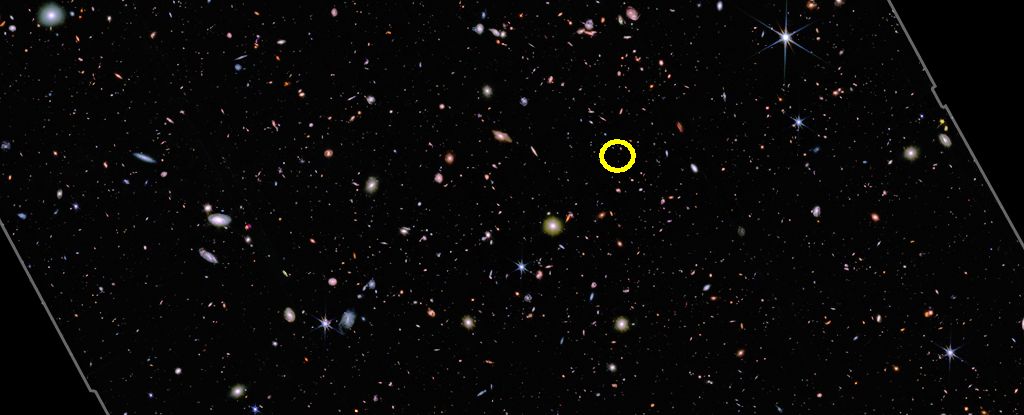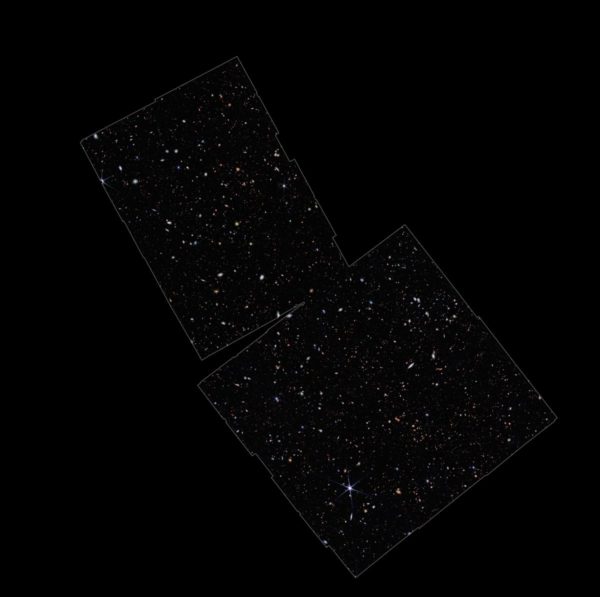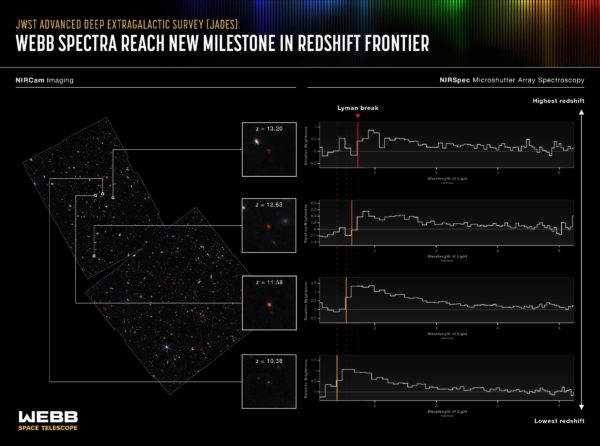
Posted on 12/15/2022 11:01:19 AM PST by Red Badger

The location of the most distant galaxy ever detected. (NASA, ESA, CSA, M. Zamani/ESA/Webb)
Light that has traveled for over 13.4 billion years to reach our neighborhood of space has been confirmed as originating from the earliest, most distant galaxy detected yet.
That places the most distant of these four very young objects at the very dawn of the Universe, just a short time after the Big Bang – a time period when the Universe was still foggy and bleary and the first rays of light were penetrating the darkness.
So detailed are the JWST's long spectroscopic observations that researchers can not only measure the distance the light of these galaxies has traveled, they can also infer some of the galaxies' properties.
"For the first time, we have discovered galaxies only 350 million years after the Big Bang, and we can be absolutely confident of their fantastic distances," says astronomer Brant Robertson from the University of California Santa Cruz.
"To find these early galaxies in such stunningly beautiful images is a special experience."
To be able to peer earlier into the Universe than we've ever seen before was one of the biggest hopes pinned on the JWST. Our understanding of the first billion years after the Big Bang is extremely limited, and finding earlier and earlier objects can help shed light on this crucial time of formation.

Diagram of region in space
The region of space examined, with blue, red and green light representing specific wavelengths. (Zamani/ESA/Webb/NASA/CSA)
We have models that describe how events unfolded. We believe that, before the first stars were born, the Universe was filled with opaque matter; any light scattered off free electrons and was unable to stream freely.
These particles gradually combined to form neutral hydrogen; when the stars started to form, they ionized the hydrogen, and light shone. This process was complete by about 1 billion years after the Universe popped into being.
The light from these objects is very faint, having traveled from so very far away. And, due to the expansion of the Universe, it's been significantly stretched into the longer, redder end of the spectrum, a phenomenon known as redshifting.
The JWST is the most powerful telescope ever launched into space, and it specializes in infrared and near-infrared light – designed for detecting this redshifted light, to the best of our ability.
To obtain a confident redshift, the light needs to be broken down into its constituent wavelengths, a technique known as spectroscopy. A team of researchers broke down the light from the JWST's NIRCam into nine wavelength ranges, focusing on four galaxies with high redshifts, two of which were first identified by Hubble.
The new JWST data confirms that these two galaxies are indeed among the most distant ever detected – and the two others are even farther away.
"It was crucial to prove that these galaxies do, indeed, inhabit the early Universe. It's very possible for closer galaxies to masquerade as very distant galaxies," says astronomer Emma Curtis-Lake of the University of Hertfordshire in the UK.
"Seeing the spectrum revealed as we hoped, confirming these galaxies as being at the true edge of our view, some further away than Hubble could see! It is a tremendously exciting achievement for the mission."

The locations of the four galaxies. (NASA, ESA, CSA, M. Zamani/ESA/Webb, Leah Hustak/STScI)
The two Hubble galaxies have redshifts of 10.38 and 11.58. The JWST's new discoveries have redshifts of 12.63 and 13.20 – the latter of which is equivalent to about 13.5 billion light-years.
Other candidates at higher redshifts are currently under investigation, but are yet to be confirmed. Given that JWST hasn't even been operational for six months yet, it probably won't be too long before the record is broken.
But there's plenty to be getting on with in the meantime. The observations that gave us these distant galaxies as part of the the JWST Advanced Deep Extragalactic Survey (JADES) collected a total of 28 hours' worth of data from a region of space in and around the famous Hubble Ultra Deep Field.
This light will be able to tell us a lot about the conditions in the early Universe, and how the first stars and galaxies formed.
"With these measurements, we can know the intrinsic brightness of the galaxies and figure out how many stars they have," Robertson says.
"Now we can start to really pick apart how galaxies are put together over time."
The researchers will be presenting their findings at the STScI's First Science Results from JWST conference. The two preprint papers can be read here and here.
WEBB PING!..................
I just love TECHNICAL TALK!.................
“For the first time, we have discovered galaxies only 350 million years after the Big Bang...”
I read that the Webb telescope had shown that there was no Big Bang.
A bit confused. What makes them think they have zeroed in on the beginning direction of the Big Bang. Maybe what they see is on the edge of the beginning of a fathomless emptiness, except for a few trillion galaxies. I was always taught there is no up or down in space, no east west, no beginning and no end.
Have the scientists started to hazard a guess as to Who (or What) made the Big Bang go “bang”?
Is it long ago in a galaxy far far away?
As Kenny Rogers and The First Edition sang, “Just Popped In (To See What Condition My Universe Was In).
And this helps me how?
How many of th these galaxies is JWST seeing more than ok nce as it looks back in time. Seekng them 13 Billion years ago, then 9 billion, than 1 billion and so on?
It helps you to realize how small and insignificant you are........................🤔
That is the eternal quest for knowledge.....What’s is beyond that next hill?................
I already knew that.
I read here on FR that one of the first big discoveries of the JWST was that the Big Bang Theory was busted. That there is no singular point of origin.
That sure is a long long time ago. And that galaxy is far far away.
Absolutely!..................Until they find another one farther away..............
talk about a road trip.. those numbers are making me dizzy!
My wife tells me every day..................
Correct on both counts. ;^)
Well, “350 million years after the ... Whatever...........
That is a plausible theory, but hardly the only plausible theory. Cosmology has more questions than answers at present.
Disclaimer: Opinions posted on Free Republic are those of the individual posters and do not necessarily represent the opinion of Free Republic or its management. All materials posted herein are protected by copyright law and the exemption for fair use of copyrighted works.